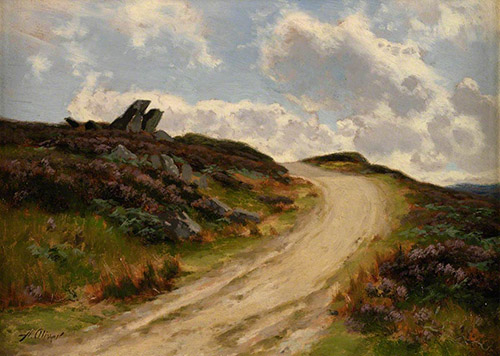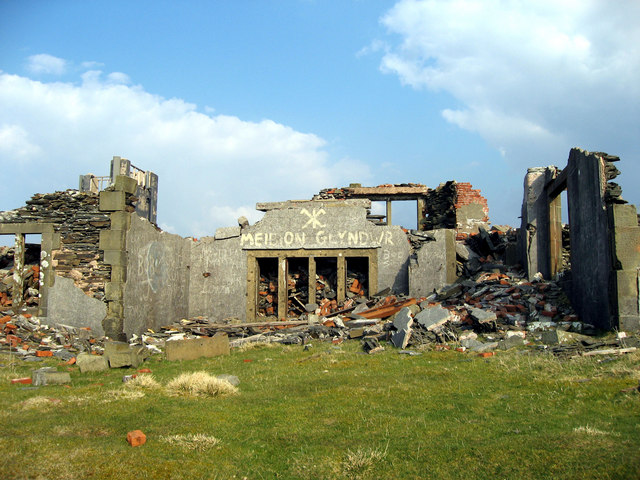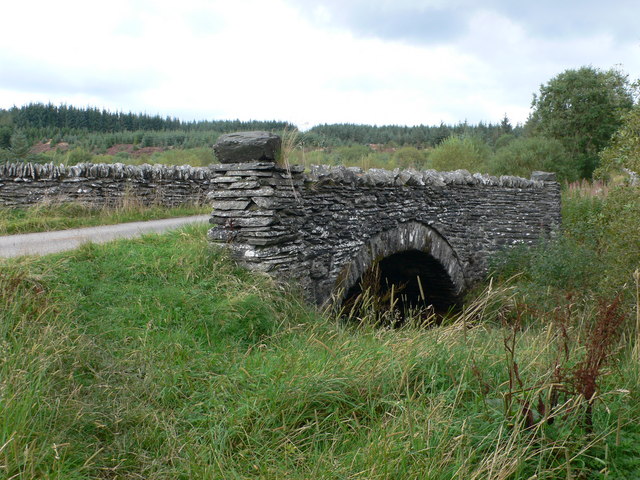The Denbigh Moors, or Mynydd Hiraethog, lie in north Wales. The area is home to two reservoirs, the Clocaenog Forest, and the Hafod Elwy Moor National Nature Reserve. At its highest point, it’s higher than Exmoor.
The moors are a wild, desolate place, home to various types of wildlife. Yet if you believe the tales, they’re also a place of ghosts and the Tylwyth Teg. A Roman Centurion apparently stalks the moors, and a ruin slowly disintegrates into the landscape.
Let’s go and look and some of the legends!
A Ghostly Roman
According to legend, the ghost of a Roman Centurion has been seen walking on the moors at least twice. The consensus is that he died in battle on the moors. He’s wearing full battle dress, and I daresay that also makes identifying him as a Roman Centurion a bit easier!
And his presence on the moors isn’t entirely unexpected. The Romans founded the Deva Vitrix fort in the AD 70s, which went on to become Chester. It lies some 28 miles to the north east of the Denbigh Moors.

Yet he’s also a death omen, apparently seen twice, both times by a group of men. On both occasions, a man from each party died after they saw the Centurion.
True, two points do not a graph make, so it’s difficult to say he’s definitively a death omen. You would need more consistency to claim that. Paranormal Database called it a crisis manifestation and said the Centurion was seen “[p]rior to witness death”, but it doesn’t say how far before that death (2023). You’d need someone to see the Centurion before their imminent demise to call it a crisis manifestation.
Still, it makes a good start.
A Haunted Watchtower
If you head north-east on the A543, you’ll be able to see a desolate ruin. It’s called Gwylfa Hiraethog, or the Watch Tower of Hiraethog, although locals still call it Plas Pren (Ian 2018). Built in the 1890s, the original building was made of wood, hence Plas Pren, or the Wooden Hall. Hudson Ewbanke Kearley, 1st Viscount Devonport, imported it from Norway.
He was both a businessman and a politician, who created the International Tea Company Stores, and served as a minister for food supplies in David Lloyd George’s cabinet. In 1908, Kearley rebuilt the house in stone following the Jacobean style, and Lloyd George himself addressed a crowd from its balcony (Tomos 2021).
Part of the location’s attractions were its excellent views, and the shooting on the moor. That helps to explain the name of the nearby pub, The Sportsman’s Arms.

But that isolation proved to be a double-edged sword.
While the house apparently had the widest views in Britain, it was also incredibly difficult to keep servants. The isolation also made it difficult to get goods to the house. Kearley sold the house in 1925 when cars made it easier to simply drive to the moors. Its final inhabitant left in 1955.
Now empty, the house fell derelict. Ian at Mysterious Britain explained in 2012 that it “deteriorated rapidly over the last twenty years” (2018). As you might expect of such an eerie-looking spot, the ruins are said to be haunted. Walkers on the moors report hearing weird noises coming from the house, or see lights moving around (Ian 2018). It is, of course, possible that such things have a human origin, but a lot of people give the ruins a wide berth now.
That’s also hardly surprising given the major ghost story in the area. A couple apparently saw a tall skeleton that glowed in the dark. It approached them and they sensibly ran away (Ian 2018). That said, as the story is told by people at the nearby Sportsman’s Arms pub, I’m actually surprised that more people haven’t reported seeing a luminous skeleton. Thankfully, a comment on the Mysterious Britain article about it did note that Richard Holland, author of Haunted Wales, confirmed the whole thing was nonsense (Ian 2018).
Now the ruins just look forlorn.

The Devil of Pont Brenig
One story, related by Elias Owen in an 1896 volume, Welsh folk-lore: a collection of the folk-tales and legends of North Wales, involves a diabolical encounter at a bridge.
A young man lived on one of the farms at Hafod Elwy. He needed to go to Denbigh on an errand and set off before dawn. The moorlands looked especially bleak on this dreary winter day.
Several miles into his journey, he noticed an inescapable sensation of dread. He had no idea what he dreaded, only that he desperately wanted to go back home.
Fearing the ridicule he’d face if he did so, he tried to boost his spirits by whistling. He tapped out a catchy rhythm with his walking stick. Eventually, he reached Pont-y-Brenig and he decided to take a rest. He leaned against the stones of the bridge, solid and reassuring in their firmness. The young man also had an ulterior motive, hoping to see or hear someone approaching.

Someone did indeed move towards him through the pale dawn light.
The tall gentleman approached, and the young man walked towards him. He got within a few yards when fear seized him and he could get no further. The gentleman wore grey, with yellow buckles fastening his breeches. Two rows of gold buttons glittered on his coat.
Yet it seems the stranger wasn’t actually pursuing the young man. He didn’t speak to him, or even pass him. Instead, he stepped into the nearby bog and vanished.
The young man, terrified as he was, finally found himself able to move, the dread having lifted. The weirdest part of the story was yet to come. Having concluded his business in Denbigh, he reversed his route to return home. When he passed the spot where he saw the stranger, he found money. Indeed, every time he passed the spot, he encountered money or valuables.
Owen refers to the stranger as “the Evil One”, with the assumption being that this grey-clad gentleman was the Devil (1896: 189). Yet he also explains that the finding of valuables “connects this tale with Fairy Folk-Lore, as the Fair People were credited with bestowing gifts on mortals” (1896: 189). My query with this is…what did the gentleman get out of leaving valuables? And did he leave valuables knowing the young man was heading that way, or did he leave them so often the young man always found them?
You can still see the Pont-y-Brenig, which is a medieval bridge near the Llyn Brenig reservoir.
Playing a Gig for Fairies
Speaking of fairies, there is a proper fairy encounter connected with the moors, related by Fiona Collins in Denbighshire Folk Tales (2011).
Siôn Robert was a harper, and he found himself in much demand to accompany singers at events across Mynydd Hiraethog. One night, he was asked to play at an event in Cefn Brith, in the next county. It meant walking across the moor to get there, but he looked forward to playing for the dancers there. The evening went better than ever, and he soon ventured out into the right to walk home.
He soon reached Llyn y Dau Ychain, a lake on the moor that helped him navigate its undulations in the dark. Forest now covers the site after the authorities drained the lake to make way for the Alwen reservoir (Well Hopper 2022).

Yet as Siôn drew near, he realised something was very different. A wonderful palace stood beside the lake, where a palace had never stood before. Its lights shone glittering reflections across the lake.
His route home took him past the palace. As he hurried along, a footman came out of the dazzling front door and called his name. When Siôn finally paused, the footman invited him in. Curiosity got the better of him, so he agreed and headed inside the palace. People enjoyed a ball inside, where a waiter offered Siôn a cup of wine.
The hostess of the evening came up to him, addressing him by name. Already knowing his reputation, she asked him to play, and Siôn obliged. Far from dancing, the attendees gathered around, fascinated by his music. When he’d finished, a man picked up Siôn’s hat and passed it around the cluster of finely dressed people. When it came back, it was full of gold.
A feast began while Siôn packed away his harp, and the footman kept him well-fed. The feast went on for hours, and by now too tired to head home, Siôn fell asleep on a couch. Those familiar with tales of the Good Folk won’t be surprised that he awoke at midday, lying on a bank of heather. The palace had vanished. So, it seemed, had the fairy gold, which had become pockets full of dried leaves.
Siôn picked up his harp and headed off for home. He never saw the palace again, but he did have the satisfaction of knowing the Tylwyth Teg enjoyed his music. Plus, he survived the encounter, which is more than can be said for some fairy meetings!
Frozen on the Moor
Our last tale is something of a sad one, about a man named Ffowc Owen. Again, Collins tells a version of this, but it also exists in ballad form (2011).
Born in the 1750s, Ffowc grew up to be a carpenter. He fell in love with Dyddgu, a maidservant who lived just down the mountain. Sadly, his father ended the romance when he found out about it. He considered Dyddgu to be beneath his son, and vowed to find a better match for him. Ffowc appealed to his mother, but she supported Ffowc’s father. Eventually, they married Ffowc off to a girl with a good dowry, and while he never forgot Dyddgu, he settled down well enough with his new wife, Nans.
A few years later, a hard winter gripped the moor. Supplies began to run out, and while Nans made the food last, Ffowc realised he had no more oak wood. The problem was, a commission was already three weeks overdue. He insisted on heading down to Nantglyn for more supplies. Having grown up on the moor, he was convinced he would be fine.

And it seemed he would be.
He made it to Nantglyn, and waited for his oak to be cut. He pottered around the village, running errands for Nans.
While the road to Nantglyn had been clear when he set off, snow began to fall again as he left. The snow turned to early afternoon to night, and Ffowc soon found himself lost on the road. He couldn’t see where he was going, and he became befuddled by the cold. The wood had become far too heavy, so he stored it beside one of the farms near Pont-y-Brenig. But instead of seeking shelter at the farm, he headed back off across the moor.
Days passed back at his homestead, and neighbours went out to search for him. It wasn’t until a reprieve from the snow that a shepherd found Ffowc’s oak stash. There was still no sign of Ffowc. Some three weeks later, Dyddgu visited Nans. It seemed she had dreamed of Ffowc cutting hay. Not only that, she’d had the same dream every night for three nights. Dyddgu was going to show them where she’d seen him in her dream, but she’d come to tell Nans in case she wanted to come too.
Sadly, the search party found Ffowc, frozen in the snow, right where Dyddgu said he would be.
According to legend, one of the memorial cairns on the moor stands there in Ffowc’s memory.
What do we make of these legends of the Denbigh Moors?
The tales of ghosts on the moors are almost inevitable, especially when you put ruins in an isolated place. Strange sounds and lights probably have a human origin, but the imagination can’t help but run wild.
Meanwhile, the legend of Siôn the Harper shows that you can survive a fairy encounter if you manage to please them. Like the story of Llyn Cwm Llych and its hidden island where humans mixed with the Tylwyth Teg, here Siôn entertains the Good Folk and they reward him. True, the gold turns into leaves in the cold light of day, but we don’t know if this was the intention of his generous hosts. Perhaps the payment was symbolic, especially since he was well-fed and looked after during the ball.
Finally, the legend of Ffowc Owen is a sad one, and it’s surprising that people don’t believe they see him wandering the moor in bad weather. But perhaps this is the point of the tale. Its unhappy ending turns it into a cautionary tale, suggesting that people avoid the moor in inclement weather, regardless of how well they know its terrain. And that’s something folklore does so well. It preserves local knowledge in a memorable format, so people can pass it on to new listeners.
Which is your favourite legend of the Denbigh Moors?
References
Collins, Fiona (2011), Denbighshire Folk Tales, Stroud: The History Press.
Ian (2018), ‘Gwylfa Hiraethog (a.k.a. Plas Pren)’, Mysterious Britain & Ireland, https://www.mysteriousbritain.co.uk/hauntings/gwylfa-hiraethog-a-k-a-plas-pren/.
Paranormal Database (2023), ‘Clwyd Ghosts, Folklore and Forteana’, Paranormal Database, https://www.paranormaldatabase.com/wales/clwyd.php.
Tomos, Ywain (2021), ‘Gwylfa Hiraethog – the Welsh Watchtower’, Royal Commission on the Ancient and Historical Monuments of Wales, https://rcahmw.gov.uk/gwylfa-hiraethog-the-welsh-watchtower/.
Well Hopper (2022), ‘Ffynnon y Fuwch Frech’, Well Hopper, https://wellhopper.wales/2022/03/01/ffynnon-y-fuwch-frech/.
Nutty about folklore and want more?
Add your email below and get these posts in your inbox every week.
You'll also get my 5-step guide to protecting your home using folklore!







It’s so strange. I listened to your Denbigh podcast today and realised that 40 years ago I was at Gwylfa Hiraethog with my then boyfriend. He was a photographer and we did a shoot there at dusk – I was dressed up in a 19th century embroidered dress made by my great-great grandmother and the props were a dagger and a mirror. He was well into goth…I don’t have the photos sadly (acrimonious break-up) but we might well have once been the source of mysterious sounds and moving lights.
That would be outstanding if that was you!!